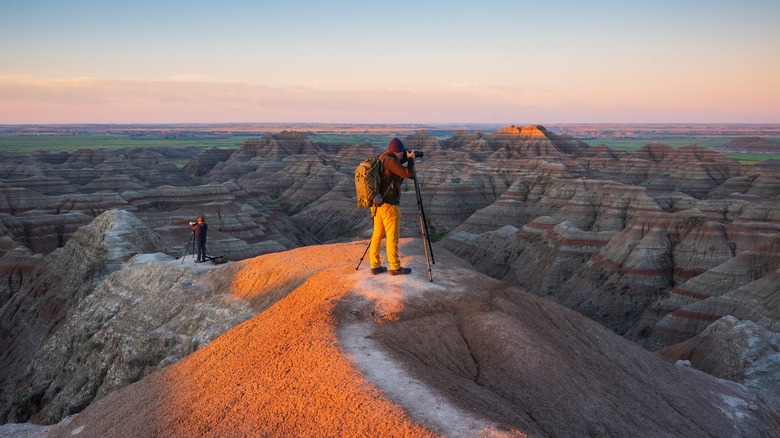This National Park Is A Hidden Gem For Breathtaking Sunrise And Sunset Views
While Badlands National Park in South Dakota may not be on many people's national park bucket list, but those familiar with the park consider it a hidden gem for breathtaking sunrise and sunset views. The area has actually been somewhat of a photographic pilgrimage for many outdoor, travel, and landscape photographers. In fact, dramatic photos of the Badlands had been circulating prior to the initial dedication of the 50,000-acre national monument in 1939. By the time the park was expanded to its current size and dedicated as a national park in 1978.
So what is it about this desolate stretch of land in South Dakota that makes for such stunning sunrises and sunsets? The simple answer is geology. While the terrain could be considered hostile, the deep canyons, steep peaks, and buttes add drama to photos. Additionally, while the park may at first glance appear devoid of life, there is actually a good deal of wildlife that inhabits the badlands. Perhaps the most critical aspect to these sensational sunrises and sunsets has to do with the half-dozen different types of soil that are layered in the park's geological formations. As the light changes throughout the day, the colors of these exposed soil layers appear to change also. The shadows cast by the peaks and buttes add yet another dimension to the scene and are constantly changing with the angle of the sun. As a result, not two sunrises or sunsets look the same at Badlands National Park.
Where to go for sunrise and sunsets in Badlands National Park
Given the Badlands National Park covers nearly 380 square miles and contains seemingly countless peaks, valleys, and buttes, in order to get the full effect of these stunning sunrises and sunsets, it is important to know where to go. Among the spots the National Parks Services suggests for viewing and photographing sunrises are Panorama Point, Door Trail, and Big Badlands Overlook. Also included are the Dillon Pass and Norbeck Pass areas. Each of these locations is ideal for sunrises because they face east. At the end of the day, west-facing areas are best for taking in the sunset. Some suggested sunset spots include Bigfoot Pass Picnic Area, Conata Basin Overlook, and Pinnacles Overlook. Those in the Norbeck Pass area can catch the sunset just as they did the sunrise if they face west. The Castle Trail also affords both sunrise (facing east) and sunset (facing west) views.
Visitors should keep in mind that the same rugged terrain that makes the scenery in Badlands National Park so dramatic also makes it a very dangerous place to hike. It is important to be properly prepared for a challenging hike, stay hydrated, and be aware of the forecast as weather extremes are the norm in the Badlands. You should also be mindful of wildlife, as the park is home to one of the most dangerous animals you could encounter – the bison. You could also come across a rattlesnake while hiking the Badlands.
Tips for stunning sunrise and sunset photos
If you are wanting to commit the scenes you see in the Badlands to more than just your memory, there are a few tips for getting stunning sunrise and sunset photos. For starters, have a plan. Know where you intend to be in order to get the photos. The window for ideal sunrise and sunset photo opportunities is deceptively short, so you need to make sure you are in position and set up well before the sun begins to ascend or descend. So, make sure you know what time the sunrise is that day and make sure you know how much time daylight is left so you can capture the sunset. It is also advisable to have a reliable flashlight, as you will be hiking to (sunrise) or from (sunset) your photo spot in the dark.
Once you are in position, consider your composition — try to incorporate the peaks and buttes, as well as wildlife or plants. You will be shooting in low light conditions, so using a low or mid-range ISO and a slower shutter speed will help capture more light. A tripod will help reduce shake and keep the photo crisp. Additionally, select a higher aperture or utilize your camera's landscape setting in order to have a greater depth of field and keep the entire landscape in focus. Finally, take plenty of shots –- you never know which one will turn out to be the one.


